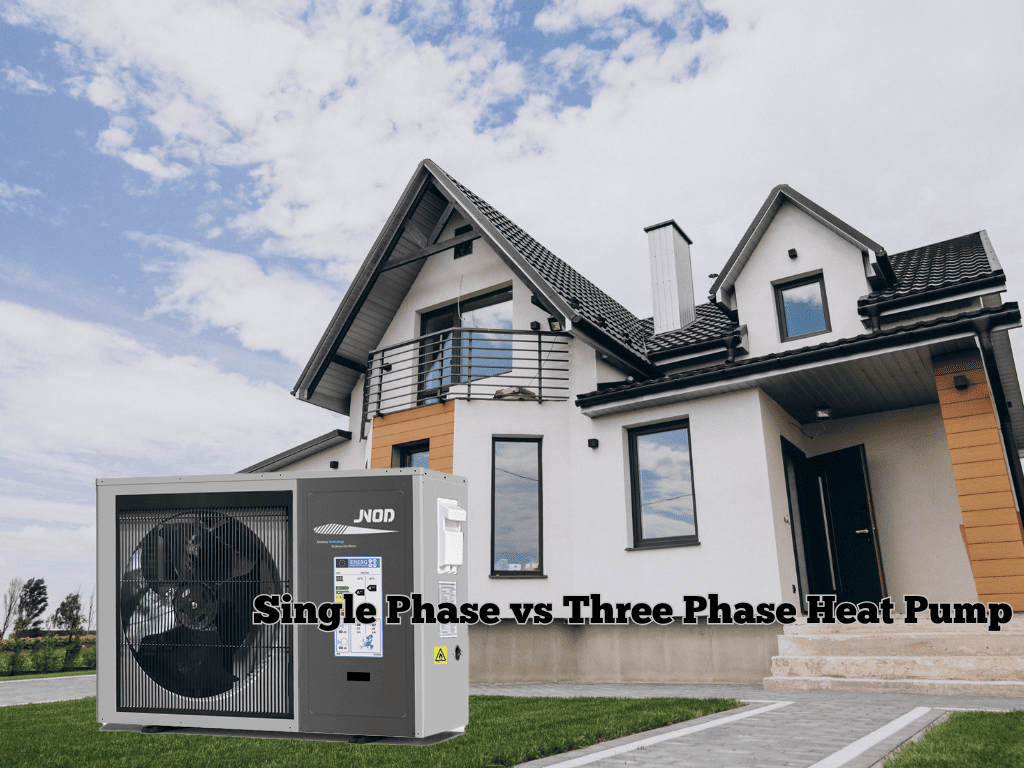
An air source heat pump is an efficient, energy-saving and eco-friendly heating, cooling & hot water solution. This makes it one of the top choices for HVAC systems for customers in recent years. When you are going to buy a heat pump, in addition to considering the brand, function and efficiency, you should also consider the power supply method – single-phase or three-phase.
In this article, we will distinguish between single-phase and three-phase electric heat pumps to help you make the most suitable heat pump choice for your specific needs.
What Is a Single-Phase Heat Pump?
Single-phase heat pumps use a single power source, which is the standard household power source (usually 220V-240V AC). It is most commonly used in small to medium-sized residential or light commercial locations. Single-phase heat pumps usually use power for the main circuit, which represents a smaller electrical load. Single-phase power outputs power in a constant waveform, which is sufficient for systems with lower power demand.
Advantages of Single-Phase Heat Pumps
Easy Installation: Easily connects to standard residential power. The power setup is simple, with only one hot and one neutral wire.
Lower Cost: Single-phase equipment and installation are generally cheaper. Only one power cord, saving cable costs.
Easy Maintenance: The simple power setup makes diagnosis and maintenance easier
Sufficient for most homes: Ideal for residential applications with moderate heating and cooling needs.
Limitations of Single-Phase Heat Pumps
Limited Power Capacity Heating: Not suitable for large buildings or high-load systems. Using single-phase power to run a large heat pump may damage other appliances in your home.
Reduced Efficiency at High Loads: Continuous or frequent use may cause stress. This leads to increased energy consumption and operating costs.
Increased motor wear: The higher current in a single phase will cause more wear on the motor, which will require more frequent repairs and maintenance.
Single-phase systems are great for small homes, but their limitations become more apparent in high-demand scenarios. Using an inverter or electronic current limiter can help, but it is not a 100% solution to the above problems.
What Is a Three-Phase Heat Pump?
Three-phase heat pumps use three-phase AC power, usually 380V to 415V. They are designed for commercial, industrial, or large residential applications. This power supply is more efficient and supports higher capacity systems. Three-phase heat pumps use three hot wires and sometimes a neutral wire. The AC power is evenly distributed across the three wires, ensuring a balanced power supply.
Advantages of Three-Phase Heat Pumps
More Power: Easily handles larger electrical loads. Does not overload circuits when starting.
Improved Efficiency: More stable power delivery, especially during high demand. Saves energy costs in the long run.
Suitable for Large Buildings: Suitable for villas, commercial spaces, and industrial facilities.
More Durable: Three-phase motors are able to handle higher currents and run at lower speeds. As a result, they are more durable and less prone to wear and tear. In the long run, three-phase heat pumps have an increased lifespan.
Adapts to Weather Changes: When the thermostat senses a large rise or fall in ambient temperature, the variable speed drive increases the speed. It also activates auxiliary or backup heating systems when necessary, reducing unnecessary energy consumption.
Typically run at low speeds: The blower and compressor of a three-phase heat pump typically run at low speeds to achieve and maintain your desired room temperature. This can reduce the heat pump’s electricity consumption by two to three times.
Limitations of Three-Phase Heat Pumps
Requires three-phase power: Not available in all residential areas.
Higher upfront costs: Additional electrical upgrades may be required before installation. Three-phase heat pumps are generally more expensive than single-phase heat pumps due to their larger capacity and complexity.
More difficult to install: Installation requires expertise and equipment, which can increase the overall time.
Key Differences: Single Phase vs Three Phase
| Feature | Single Phase | Three Phase |
|---|---|---|
| Voltage | 220V–240V | 380V–415V |
| Use Case | Homes, light commercial | Large homes, commercial, industrial |
| Efficiency | Lower at high loads | High and consistent |
| Installation | Simpler | More complex |
| Cost | Lower | Higher |
Single Phase vs Three Phase Heat Pump: Choose Which One?
When comparing single-phase vs three-phase heat pumps, your decision should be based on several factors:
- Building Size and Load Demand
- Choose single-phase heat pumps for small homes with basic heating and cooling needs.
- Choose three-phase heat pumps for large homes, commercial buildings, or if your heating demand is high.
- Availability of Power Supply
- If your location does not support three-phase power, single-phase is your only option—unless you upgrade your electrical system.
- Budget and Efficiency Goals
- Single-phase units are cost-effective for small spaces.
- Three-phase systems, while more expensive, offer better performance for high-demand applications.
Conclusion
The choice between single-phase vs three-phase heat pumps depends on your specific needs, the size of your building, and the available electrical infrastructure. For residential applications with moderate energy needs, a single-phase system is usually sufficient. For larger or more demanding setups, a three-phase system ensures better efficiency and reliability.
Before making a final decision, consult with a certified HVAC professional to assess your property’s requirements and ensure you choose the most suitable system.
